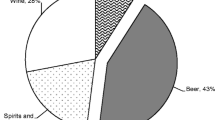Abstract
This work compares the life cycles of returnable and non-returnable beer bottles. The methodology, principles and framework adopted are those proposed by SETAC’s working group. The “Critical Dilution Volume” method is used to evaluate the inventory data and perform the environmental impact assessment. The inventory data was obtained from two Portuguese industries and compared with the BUWAL database. The differences between returnable and one-way beer bottles were analysed and show that recycling of glass bottles provides larger environmental benefits than reuse.
Access this chapter
Tax calculation will be finalised at checkout
Purchases are for personal use only
Preview
Unable to display preview. Download preview PDF.
Similar content being viewed by others
References
BUWAL (1991) Inventaires Écologiques Relatifs aux Emballages Cahier de L’environnment No 123, Swiss Federal Office of Environment, Forests and Landscape, Zurich, Switzerland.
BUWAL (1997) Inventaires Écologiques Relatifs aux Emballages, Cahier de L’environnment No 250/I et No 250/II, Swiss Federal Office of Environment, Forests and Landscape, Zurich, Switzerland.
Consoli, F.; Allen, D.; Bousted, I.; Fava, J.; Franklin, W. et al. (1993) Guidelines for Life-Cycle Assessment: A Code of Practice, SETAC, Brussels, Belgium.
EC/62/1994 Council Directive on Packaging and Packaging Waste.
Habersatter, K. (1991) Ecobalance of Packaging Materials State of 1990, Swiss Federal Office of Environment, Forests and Landscape, Zurich, Switzerland.
International Standard TC207/SC5/DIS14040 (1997) International Organization for Standardisation, Environmental Management - Life Cycle Assessment - Principles and Framework.
Jensen et al. (1997) Life Cycle Assessment — a Guide to Approaches, Experiences and Information Sources, Report to the European Environmental Agency Concerning Service Contract No. 300/SERl9600235/96/gbl.lca, Copenhagen.
Kooijman, J. (1993) Environmental Assessment of Packaging: Sense and Sensibility, Packaging Technology & Science, 17, p.575–586.
Kooijman, J. (1994) Environmental Assessment of Food Packaging: Impact and Improvement, Packaging Technology & Science, 7, p.111–121.
Kooijman, J. (1996) The Environmental Impact of Packaging Performance in the Food Supply System, Journal of Waste Management & Resource Recovery, 3, p.73–96, 1996.
Levy, G. M. (1993) Packaging in the Environment, p.1–33, Blackie Academic & Professional, London.
Lox, F. (1994) Waste Management - Life Cycle Analysis of Packaging, Final Report of Contract Number B4–3040/014093 for European Commission DGXI/A/4, Belgium.
Lundholm M., P ; Sundström, G. (1986) Tetra Brik Environmental Profile Report Tetrapak, Sweden.
Lundholm M., P ; Sundström, G. (1989) Tetra Brik Aseptic Environmental Profile, Report Tetrapak, Sweden.
Mata, T. (1998) Comparação de Processos de Reutilização e Reciclagem, usando a Metodologia de Análise de Ciclo-de-Vida, M. Sc. Thesis, Departamento de Engenharia Química, Faculdade de Engenharia da Universidade do Porto, Portugal.
SETAC (1992) Life cycle assessment: inventory, classification, valuation, databases, Society of Environmental Toxicology and Chemistry, workshop report, Leiden.
Schaltegger, S. et.al. (1996) Life Cycle Assessment (LCA)-Quo vadis? Birkhauser Verlag, Germany.
Steen, B.; Ryding S-O. (1992) The EPS Enviro-Accounting Method, Swedish Environmental Research Institute (IVL), Sweden.
Udo de Haes, H., A. (1996) Towards a Methodology for Life Cycle Impact Assessment, Society of Environmental Toxicology and Chemistry, Europe.
UNEP (1996) Environmental Management in the Brewing Industry, United Nations Environmental Programme, Industry and Environment, Technical Report n°33.
Vignon, A., (1988) Recycling is the Future for Glass, Emballage Dig, no.318, France.
Author information
Authors and Affiliations
Editor information
Editors and Affiliations
Rights and permissions
Copyright information
© 1999 Springer Science+Business Media Dordrecht
About this chapter
Cite this chapter
Mata, T.M., Costa, C.A.V. (1999). LCA: Comparison Between Recycle and Reuse of Glass Beer Bottles. In: Sikdar, S.K., Diwekar, U. (eds) Tools and Methods for Pollution Prevention. NATO Science Series, vol 62. Springer, Dordrecht. https://doi.org/10.1007/978-94-011-4445-2_7
Download citation
DOI: https://doi.org/10.1007/978-94-011-4445-2_7
Publisher Name: Springer, Dordrecht
Print ISBN: 978-0-7923-5926-5
Online ISBN: 978-94-011-4445-2
eBook Packages: Springer Book Archive




